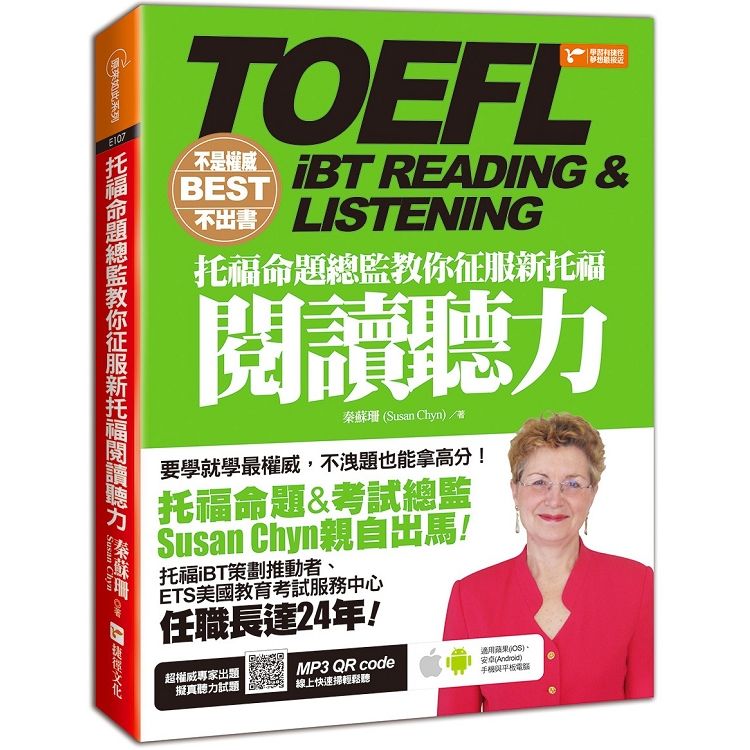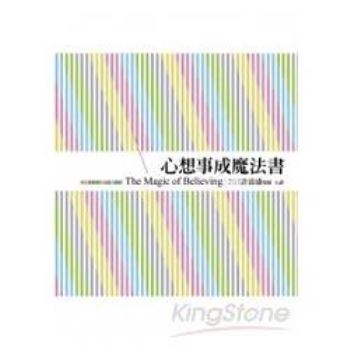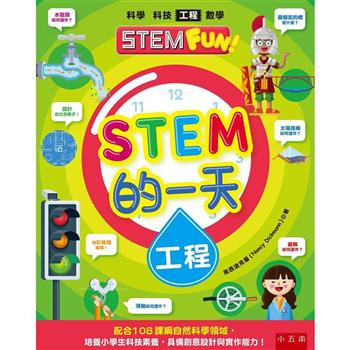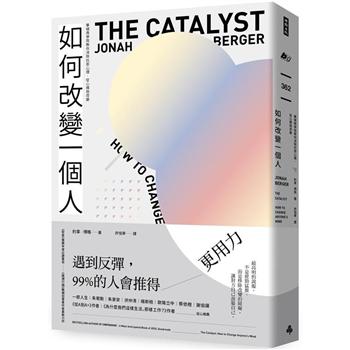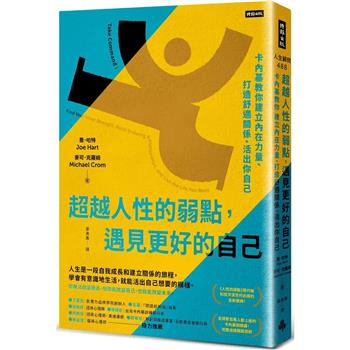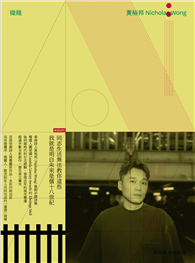章節試閱
1 Physical Sciences, Topic 1:Astronomy物理科學常考主題1:天文學
本章內容以物理科學範疇的天文學為知識背景。天文學是研究空間的科學,其研究對象包括行星、恆星、星系、彗星和星雲等,所以常用詞彙有Mars(火星)、Venus(金星)、
meteorite(隕石)以及物理學相關片語如speed of light(光速)和zero gravity(零重力,失重狀態)等。請注意本章中出現的片語,並記住它們。
天文學:閱讀
▼句子簡化題型答題策略1
換句話說的能力和識別話句話說後資訊的能力對解答所有新托福考試題都很重要,而其重要性在解答「句子簡化題」時尤為突出。此類試題的應對策略有很多,不過首要的一步是一定要弄清楚句子的文法結構和加粗部分的意思,特別是要準確找出句子的主詞。瞭解標點符號和修飾性片語與子句的用法會大有幫助,因為複合句中常含有各種子句和分詞片語結構,而這些都是句子簡化題考查的內容。如果這方面的知識不夠的話,就有可能會把一個作修飾性成分的名詞片語誤以為是句子的主詞,以致作出錯誤選擇並丟分。
下面舉一個例子,這題也會在接下來的擬真試題中出現:
• Reading Sample
Which of the sentences below best expresses the essential information in the highlighted sentence in the passage? Incorrect choices change the meaning in major ways or leave out important information.
Subsequent to Leavitt’s discovery of what are now referred to as the Cepheid-variables of the Small Magellanic Cloud, researchers could use variable stars as a cosmic yardstick.
A. After researchers started using standard measurements, Leavitt could identify the variables now called Cepheid variables.
B. In their work to measure the universe, scientists were able to make use of the variable stars found by Leavitt.
C. Scientists could have made use of the Cepheid variable stars if only Leavitt had access to more precise tools.
D. Previous to Leavitt, some researchers had detected what appeared to be variable stars, but their measurements of the cosmos turned out to be inaccurate.
托福總監評析
要先弄清楚試卷中加粗句子的結構,所以先找到句子裡的逗號,逗號前面是subsequent to( 在⋯⋯之後)引導的很長的介詞片語,而逗號後面則是一個獨立的主句,主詞為researchers。分清這一點很重要,因為現在就可以把關注重點放在主詞的訊息上,即研究者們能夠把變星(variable stars)用作宇宙衡量的一種標準。根據這一資訊便可排除 C 項和 D 項。A 項是干擾項,因為本句的主詞並不是Leavitt。
當然,單憑對標點和文法規則的瞭解是不夠的,還必須能夠理解句子中的詞彙片語及其他同義表達方式。下面來看一些原句中的片語及其同義表達方式:
Researchers → scientists
Leavitt’s discovery of [stars] → [stars] found by Leavitt
could use⋯ → were able to make use of⋯
▼擬真訓練
Henrietta Leavitt and the Stars
(1) At the end of the 19th century, Harvard University purchased 12 acres of land called Summer House Hill on which to build a large telescope. Harvard hoped eventually to establish the largest observatory in the world. Today the telescope is no longer in operational use, but Harvard’s “Great Refractor” was for many years state-of-the-art technology. An advanced 15-inch-diameter lens was ordered from Munich, Germany, and installed, and on an afternoon in June, 1847, the first observation took place, of the Moon.During the early decades, the observatory was largely engaged in determining stellar positions as well as the observation of planets, variable stars, comets, and nebulae.
(2) Then, in 1877, a physicist named Edward Pickering took over the laboratory and began to oversee the work of cataloging the brightness of stars. It is important to note that astronomical studies of the time focused largely on two details: a star’s position and a star’s motion in space. Pickering, however, realized that there was little data on a star’s true brightness, or luminosity, and its color, a characteristic that could indicate the chemical composition of the star.
(3) Henrietta Leavitt arrived at the observatory in 1893, where she would work for seven hours a day, six days a week, for 25 cents an hour. In the days when women were often barred from scientific careers, Leavitt was known as a “computer” or a “counter,” hired to calculate the positions and brightness of stars in astronomical photographs. Few men were interested in such tedious work, so the jobs usually went to women. Looking at tiny dots on photographic plates, Leavitt compared each pinpoint against stars whose brightness was already known. During a time exposure, the brighter stars leave larger spots on a photographic plate, chemically darkening more grains. Size is therefore an indicator of brightness. Early on Pickering had asked Leavitt to look for “variable stars,”stars that waxed and waned with regularity. Some of these variable stars completed a cycle every few days; other cycles took weeks, even months. The rhythms were slow and subtle. Only by measuring stars at various intervals through the year could one detect the variations in luminosity.
(4) Over the many years Leavitt spent poring over photographic plates containing thousands of stars, she was able to observe certain relationships between the average
apparent brightness, in other words the magnitude of luminosity as observed from the Earth, and the period, or cycle length, of certain stars. Leavitt looked at the vast stellar mass in the two Magellan Clouds and analyzed the variable stars. She plotted 25 of these on a graph, with brightness on one axis and period on the other. It dawned on her that the longer the period of a variable star, the greater its natural brightness, a relation which we now know is based on the fact that brightness is proportional to surface area. This is because large, bright variable stars pulsate over a relatively long period just as large bells resonate at a lower frequency (or longer period) than smaller bells.
(5) Subsequent to Leavitt’s discovery of what are now referred to as the Cepheid-variables of the Small Magellanic Cloud, researchers could use variable stars as a cosmic yardstick.They were eager to answer such questions “How big is the universe?” Drawing on Leavitt’s work, the legendary astronomer Edwin Hubble compared the apparent brightness of the Cepheid variable stars with their “absolute brightness”—a measure equal to the apparent brightness a star would have if it were located exactly 32.6 light-years away from the Earth. In this way, Hubble was able to determine a Cepheid’s distance from our planet.Hubble’s method worked because Cepheids with the same periods have about the same absolute brightness.
(6) As a result in 1919 Edwin Hubble definitively showed that stars existed beyond the Milky Way. Most scientists at that time held that the universe was only as large as the Milky Way and that it was a constant size, and Hubble’s idea that the Milky Way was just one of many changed forever the way we view our place in the universe.
cosmic yardst• Reading Questions
1. According to Paragraph 2, what attribute of a star provides information about its dick → something chemical makeup?
A. Its luminosity.
B. Its color.
C. Its location.
D. Its pulsing.
2. According to Paragraph 3, what task was Henrietta Leavitt employed to do at the observatory?
A. Measure variations in stars’ gravity.
B. Create a catalog of black holes.
C. Make photographs of heavenly bodies.
D. Evaluate the brightness of stars.
3. The word “subtle” in Paragraph 3 is closest in meaning to_________ .
A. unobvious
B. unimportant
C. demanding
D. repetitive
4. The phrase “poring over” in Paragraph 4 is closest in meaning to ________.
A. processing
B. mapping
C. modifying
D. examining
5. The word “other” in Paragraph 4 refers to ________.
A. graph
B. brightness
C. axis
D. period
6. In Paragraph 4, why does the author mention “bells”?
A. To illustrate how size relates to luminosity.
B. To show what happens to sound in a vacuum.
C. To make a point about the speed of light.
D. To indicate the curved shape of variable stars.
7. What can be inferred about the Great Refractor in the 1890s?
A. It was no longer considered advanced technology.
B. It was not able to see the Magellanic Clouds.
C. It was often borrowed by foreign countries.
D. It was used to take photographs of stellar matter.
8. Which of the sentences below best expresses the essential information in the highlighted sentence in the passage? Incorrect choices change the meaning in major
ways or leave out important information.
Subsequent to Leavitt’s discovery of what are now referred to as the Cepheid-variables of the Small Magellanic Cloud, researchers could use variable stars as a cosmic yardstick.
A. After researchers started using standard measurements, Leavitt could identify the variables now called Cepheid variables.
B. In their work to measure the universe, scientists were able to make use of the variable stars found by Leavitt.
C. Scientists could have made use of the Cepheid variable stars if only Leavitt had access to more precise tools.
D. Previous to Leavitt, some researchers had detected what appeared to be variable stars, but their measurements of the cosmos turned out to be inaccurate.
9. According to Paragraph 5, what data about Cepheids did Edwin Hubble NOT make use of to calculate their distance from the Earth?
A. Their periods.
B. Their constellations.
C. Their absolute brightness.
D. Their apparent brightness.
10. The phrase “drawing on” in Paragraph 5 is closest in meaning to _________ .
A. illustrating
B. revising
C. utilizing
D. approaching
11. According to Paragraph 6, in the beginning of the 1900s what did scientists generally believe to be true about the universe?
A. The universe was expanding.
B. The universe included several galaxies.
C. The Milky Way was constantly gaining new stars.
D. The Milky Way housed all heavenly bodies.
12. The word “definitively” in Paragraph 6 is closest in meaning to _________.
A. of course
B. against all odds
C. conclusively
D. brightly
13. Directions: An introductory sentence for a brief summary of the passage is provided below. Complete the summary by selecting the THREE answer choices that express asure the most important ideas in the passage. Some answer choices do not belong in the summary because they express ideas that are not presented in the passage or are minor ideas in the passage.
This question is worth 2 points.
This passage discusses how activities at the Harvard observatory in the late 19th century changed the way in which astronomers looked at the universe.
Answer Choices
1. Although a star’s coordinates can be found on a star chart, they are not always accurate.
2. 19th-century scientists knew that the Magellanic Clouds contained millions of stars that were located just outside our galaxy.
3. Henrietta Leavitt was able to calculate the distance between the Cepheid variable stars and the Earth.
4. By comparing a Cepheid’s apparent brightness to its absolute brightness, astronomers were able to determine a celestial body’s distance from the Earth.
5. he luminosity of bright Cepheid stars was found to fluctuate over relatively long intervals.
6. Based on data regarding the distances of variable stars, astronomers reevaluated their assumptions about the Milky Way.
universe關鍵詞語
• Great Refractor 大折射望遠鏡(特指19 世紀哈佛大學購買的望遠鏡)
• period 週期
• state-of-the-art technology最先進的技術
• stellar mass 星群
• comet 彗星
• the Magellanic Clouds 麥哲倫雲
• nebula (pl. nebulae) 星雲
• the longer the…, the greater the… ⋯⋯越長,⋯⋯越大
• take over 接收,接管
• ... is proportional to...⋯⋯與⋯⋯成正比
• there was little data on...關於⋯⋯的資料很少
• resonate at a... frequency以⋯⋯頻率共振
• luminosity (恆星等的)光度,亮度
• the Cepheid variable star 造父變星
• be barred from 禁止,不准
• absolute brightness 絕對亮度
• wax and wane (月的)盈虧,圓缺
• the Milky Way 銀河
• apparent brightness 視亮度(指地球上肉眼所見的某個星體的亮度)
• 最後再來個小小練習!
Write a correct paraphrase for each of the following sentences.
a Today the telescope is no longer in operational use, but Harvard’s “Great Refractor”was for many years state-of-the-art technology.
b Looking at tiny dots on photographic plates, Leavitt compared each pinpoint against stars whose brightness was already known.
c Only by measuring stars at various intervals through the year could one detect the variations in luminosity.
天文學:聽力
▼如何做好筆記
學術講座的時長為4 ∼ 5 分鐘,這表示考生聽到的資訊量非常大。有時,教授會開門見山、直接切入主題,但有時,教授在開頭會先講某項該交的作業或上週講授的課程內容。
要想確保跟上教授的思路,唯一的辦法就是多記筆記,記下講座的重點大意、重要的細節資訊和例證。
然而,快速記筆記是有難度的,尤其是用英語記,而且結構混亂的筆記也不易閱讀,因此最好的策略是記「結構性筆記」。其目的是使考生在以一定的格式記錄單字和片語的
同時,也能掌握講座的組織結構。這樣記筆記就能輕鬆把握教授的思路,並更好地預測後面將會談論的內容。
記筆記的方法有很多,考生需要多加練習,找到最適合自己的方法。有些考生以提綱形式記筆記,如下所示:
Intro(開頭)
Main idea(中心大意)
Key concept(主要觀點)
Example(例證)
Example(例證)
Contrasting concept(反方觀點)
Example(例證)
St Q(學生問題)
Prof Ans(教授回答)
1 Physical Sciences, Topic 1:Astronomy物理科學常考主題1:天文學
本章內容以物理科學範疇的天文學為知識背景。天文學是研究空間的科學,其研究對象包括行星、恆星、星系、彗星和星雲等,所以常用詞彙有Mars(火星)、Venus(金星)、
meteorite(隕石)以及物理學相關片語如speed of light(光速)和zero gravity(零重力,失重狀態)等。請注意本章中出現的片語,並記住它們。
天文學:閱讀
▼句子簡化題型答題策略1
換句話說的能力和識別話句話說後資訊的能力對解答所有新托福考試題都很重要,而其重要性在解答「句子簡化題」時...
目錄
• 托福總監話說前頭
• 作者序
第1部分An Overview of the TOEFL iBT新托福考試怎麼命題
• What the TOEFL iBT Measures新托福考試考什麼
• A Comprehensive Look at the Reading and Listening Sections新托福考試怎麼命題:閱讀和聽力命題全解
第2部分How to Prepare for Academic Reading and Listening學術類閱讀和聽力怎麼考
1. Physical Sciences, Topic 1: Astronomy物理科學常考主題1:天文學
2. Humanities and the Arts, Topic 1: Crafts and Folk Arts人文藝術常考主題1:民俗藝術
3. Life Sciences, Topic 1: Zoology生命科學常考主題1:動物學
4. Social Sciences, Topic 1: Psychology社會科學常考主題1:心理學
5. Physical Sciences, Topic 2: Geology and Seismology物理科學常考主題2:地質學和地震學
6. Humanities and the Arts, Topic 2: Literature人文藝術常考主題2:文學
7. Life Sciences, Topic 2: Ecology生命科學常考主題2:生態學
8. Social Sciences, Topic 2: Anthropology社會科學常考主題2:人類學
9. Physical Sciences, Topic 3: Acoustics and Dynamics物理科學常考主題3:聲學和力學
10. Humanities and the Arts, Topic 3: Music and Music History人文藝術常考主題3:音樂和音樂史
11. Life Sciences, Topic 3: Cell Biology生命科學常考主題3:細胞生物學
12. Social Sciences, Topic 3: Law社會科學常考主題3:法學
13. Physical Sciences, Topic 4: Chemistry and Biochemistry物理科學常考主題4:化學和生物化學
14. Humanities and the Arts, Topic 4: History人文藝術常考主題4:歷史
15. Life Sciences, Topic 4: Anatomy and Physiology生命科學常考主題4:解剖學與生理學
16. Social Sciences, Topic 4: Mass Communication社會科學常考主題4:大眾傳播學
17. Physical Sciences, Topic 5: Computers and Software Engineering物理科學常考主題5:電腦和軟體工程
18. Humanities and the Arts, Topic 5: Art and Art History人文藝術常考主題5:藝術和藝術史
19. Life Sciences, Topic 5: Evolution and Genetics生命科學常考主題5:進化學和遺傳學
20. Social Sciences, Topic 5: Marketing and Business社會科學常考主題5:市場行銷學與商學
第3部分對話類How to Prepare for Conversational Listening聽力怎麼考
21. Frequently Tested Campus Life Contexts 1常考校園生活場景1
• 辦公時間對話:寫推薦信
• 服務諮詢對話:學生宿舍維修問題
22. Frequently Tested Campus Life Contexts 2常考校園生活場景2
• 辦公時間對話:考試問題
• 服務諮詢對話:學生兼職問題
23. Frequently Tested Campus Life Contexts 3常考校園生活場景3
• 辦公時間對話:專業與興趣問題
• 服務諮詢對話:圖書館借書
24. Frequently Tested Campus Life Contexts 4常考校園生活場景4
• 辦公時間對話:學生換專業
• 服務諮詢對話:電腦維修
25. Frequently Tested Campus Life Contexts 5常考校園生活場景5
• 辦公時間對話:論文書寫討論
• 服務諮詢對話:開學註冊與付款問題
26. Frequently Tested Campus Life Contexts 6常考校園生活場景6
• 辦公時間對話:論文提交問題
• 服務諮詢對話:失物事件
27. Frequently Tested Campus Life Contexts 7常考校園生活場景7
• 辦公時間對話:職業選擇
• 服務諮詢對話:組建大學俱樂部
28. Frequently Tested Campus Life Contexts 8常考校園生活場景8
• 辦公時間對話:實驗結果討論
• 服務諮詢對話:違反宿舍管理制度的問題
附錄
• Appendix I: The Scoring of the TOEFL iBT
附錄1 新托福考試評分
• Appendix II: Words, Answers, Explanations, and Listening Scripts
附錄2 主題詞匯、答案、 解析和錄音原文
1. 物理科學常考主題1 天文學詞彙、答案、解析和錄音原文
2. 人文藝術常考主題1 民俗藝術詞彙、答案、解析和錄音原文
3. 生命科學常考主題1 動物學詞彙、答案、解析和錄音原文
4. 社會科學常考主題1 心理學詞彙、答案、解析和錄音原文
5. 物理科學常考主題2 地質學和地震學詞彙、答案、解析和錄音原文
6. 人文藝術常考主題2 文學詞彙、答案、解析和錄音原文
7. 生命科學常考主題2 生態學詞彙、答案、解析和錄音原文
8. 社會科學常考主題2 人類學詞彙、答案、解析和錄音原文
9. 物理科學常考主題3 聲學和力學詞彙、答案、解析和錄音原文
10. 人文藝術常考主題3 音樂和音樂史詞彙、答案、解析和錄音原文
11. 生命科學常考主題3 細胞生物學詞彙、答案、解析和錄音原文
12. 社會科學常考主題3 法學詞彙、答案、解析和錄音原文
13. 物理科學常考主題4 化學和生物化學詞彙、答案、解析和錄音原文
14. 人文藝術常考主題4 歷史詞彙、答案、解析和錄音原文
15. 生命科學常考主題4 解剖學和生理學詞彙、答案、解析和錄音原文
16. 社會科學常考主題4 大眾傳播學詞彙、答案、解析和錄音原文
17. 物理科學常考主題5 電腦和軟體工程詞彙、答案、解析和錄音原文
18. 人文藝術常考主題5 藝術和藝術史詞彙、答案、解析和錄音原文
19. 生命科學常考主題5 進化學和遺傳學詞彙、答案、解析和錄音原文
20. 社會科學常考主題5 市場行銷學與商學詞彙、答案、解析和錄音原文
21. 常考校園生活場景1 詞彙、答案、解析和錄音原文
22. 常考校園生活場景2 詞彙、答案、解析和錄音原文
23. 常考校園生活場景3 詞彙、答案、解析和錄音原文
24. 常考校園生活場景4 詞彙、答案、解析和錄音原文
25. 常考校園生活場景5 詞彙、答案、解析和錄音原文
26. 常考校園生活場景6 詞彙、答案、解析和錄音原文
27. 常考校園生活場景7 詞彙、答案、解析和錄音原文
28. 常考校園生活場景8 詞彙、答案、解析和錄音原文
• 托福總監話說前頭
• 作者序
第1部分An Overview of the TOEFL iBT新托福考試怎麼命題
• What the TOEFL iBT Measures新托福考試考什麼
• A Comprehensive Look at the Reading and Listening Sections新托福考試怎麼命題:閱讀和聽力命題全解
第2部分How to Prepare for Academic Reading and Listening學術類閱讀和聽力怎麼考
1. Physical Sciences, Topic 1: Astronomy物理科學常考主題1:天文學
2. Humanities and the Arts, Topic 1: Crafts and Folk Arts人文藝術常考主題1:民俗藝術
3. Life Sciences, Topic 1: ...

